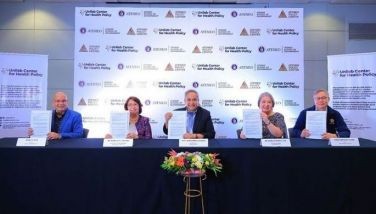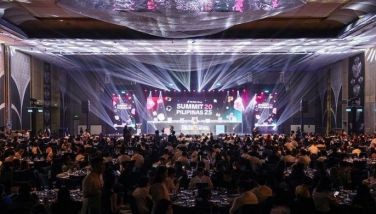A Helping Hand
July 23, 2003 | 12:00am
Did you know that aside from Toyota, then under Delta Motors, one of the earliest Japanese car makers to locally assemble their products in the Philippines is Mazda? Known then as Toyo Kogyo Industries, Mazda started assembling vehicles in the country in 1974. Hino, the giant Japanese truck maker followed suit with Pilipinas Hino, Inc. and started local production in 1975 at their plant in Valenzuela, Bulacan.
These trivia facts as well as the current programs and activities between ASEAN member countries and Japanese car manufacturers can be found in "Hand-in-Hand — Partnership in the Auto Industry between ASEAN and Japan", an English language publication of the Japan Automobile Manufacturers Association (JAMA). The issue was personally handed to invited members of the local media by Hiroyuki Nakamura, JAMA’s chief representative from its Singapore office over a luncheon meeting last Monday (July 21) at the Ben Kay Japanese Restaurant at the Dusit Hotel in Makati.
Mr. Nakamura presented to the media some of the programs that JAMA hopes would help increase the cooperation between ASEAN countries and Japanese car manufacturers. He spoke lengthily about the "Expert Dispatch Program" which is a program aimed at bolstering the competitiveness of ASEAN automobile support industries by assigning Japanese production experts as coordinators or advisers to different parts manufacturing companies within the ASEAN Region. These experts provide technical assistance, human resource development and guidance on process improvement such as 7S and Kaizen to local automobile supporting industries on a "roving" basis. They are not permanently assigned to one local parts company like an expat or a foreign consultant, but oversee several companies where they stay for a maximum of one week before they move to the next assignment. They return to each company after a month to monitor its progress, evaluate the results and submit a progress report to JAMA.
Mr. Nakamura stated that the program is voluntary and added that car manufacturers in Japan often farm out component work to successful participants of the program. He hopes that the program increases the competitiveness of Philippine parts suppliers not only in the Japanese market, but in the world automotive market as well. He cites the Filipino’s resourcefulness and his ability to speak English effectively as our country’s advantages compared to our ASEAN neighbors.
He also pointed out that along with the progress in the integration of ASEAN economies and the globalization of the automobile industry, the challenges facing ASEAN and Japanese car industries are becoming more common. To create greater cooperation between JAMA and the ASEAN Automobile Federation (AAF) which is headed by Vicente Mills, Jr. of the Philippines, the two organizations decided to launch the JAMA-AAF Meeting. The meeting discusses the future prospects of the regions car industry including the progress of the ASEAN Free Trade Agreement (AFTA) implementation as well as exchange opinions on future policies for various conferences and support programs between ASEAN and Japan. The JAMA-AAF Meeting spearheaded the Conference on Auto Supporting Industries held last year at the Philippine Trade Training Center and the AMEICC-WGAI or the ASEAN Economic Ministers and Ministry of Economy, Trade and Industry of Japan Consultations (AEM-METIE) Economic and Industrial Cooperation Committee (AMEICC)-Working Group on Automotive Industry (WGAI).
What could we expect from all these JAMA activities? Mr. Nakamura stated that he hope our country can increase its exports to ASEAN markets, as well as other global markets so it could balance the scale of economics. He also sees the region as a unified market under the AFTA and hopes that the Philippine economy will grow as fast as its neighbors. He added that once the economy improves, more Filipinos can afford to buy cars, which will generate more jobs and further strengthen the economy.
When asked about the impending changes in the excise tax system, Mr. Nakamura said that he hoped that the government could stabilize its policies to attract more investors in the local automotive industry. He added that the country can excite the industry further through consistency, transparency and fairness in government policies.
JAMA through Nakamura-san has extended a helping hand to our unstable local car industry. Here’s hoping that our government does so, too.
These trivia facts as well as the current programs and activities between ASEAN member countries and Japanese car manufacturers can be found in "Hand-in-Hand — Partnership in the Auto Industry between ASEAN and Japan", an English language publication of the Japan Automobile Manufacturers Association (JAMA). The issue was personally handed to invited members of the local media by Hiroyuki Nakamura, JAMA’s chief representative from its Singapore office over a luncheon meeting last Monday (July 21) at the Ben Kay Japanese Restaurant at the Dusit Hotel in Makati.
Mr. Nakamura presented to the media some of the programs that JAMA hopes would help increase the cooperation between ASEAN countries and Japanese car manufacturers. He spoke lengthily about the "Expert Dispatch Program" which is a program aimed at bolstering the competitiveness of ASEAN automobile support industries by assigning Japanese production experts as coordinators or advisers to different parts manufacturing companies within the ASEAN Region. These experts provide technical assistance, human resource development and guidance on process improvement such as 7S and Kaizen to local automobile supporting industries on a "roving" basis. They are not permanently assigned to one local parts company like an expat or a foreign consultant, but oversee several companies where they stay for a maximum of one week before they move to the next assignment. They return to each company after a month to monitor its progress, evaluate the results and submit a progress report to JAMA.
Mr. Nakamura stated that the program is voluntary and added that car manufacturers in Japan often farm out component work to successful participants of the program. He hopes that the program increases the competitiveness of Philippine parts suppliers not only in the Japanese market, but in the world automotive market as well. He cites the Filipino’s resourcefulness and his ability to speak English effectively as our country’s advantages compared to our ASEAN neighbors.
He also pointed out that along with the progress in the integration of ASEAN economies and the globalization of the automobile industry, the challenges facing ASEAN and Japanese car industries are becoming more common. To create greater cooperation between JAMA and the ASEAN Automobile Federation (AAF) which is headed by Vicente Mills, Jr. of the Philippines, the two organizations decided to launch the JAMA-AAF Meeting. The meeting discusses the future prospects of the regions car industry including the progress of the ASEAN Free Trade Agreement (AFTA) implementation as well as exchange opinions on future policies for various conferences and support programs between ASEAN and Japan. The JAMA-AAF Meeting spearheaded the Conference on Auto Supporting Industries held last year at the Philippine Trade Training Center and the AMEICC-WGAI or the ASEAN Economic Ministers and Ministry of Economy, Trade and Industry of Japan Consultations (AEM-METIE) Economic and Industrial Cooperation Committee (AMEICC)-Working Group on Automotive Industry (WGAI).
What could we expect from all these JAMA activities? Mr. Nakamura stated that he hope our country can increase its exports to ASEAN markets, as well as other global markets so it could balance the scale of economics. He also sees the region as a unified market under the AFTA and hopes that the Philippine economy will grow as fast as its neighbors. He added that once the economy improves, more Filipinos can afford to buy cars, which will generate more jobs and further strengthen the economy.
When asked about the impending changes in the excise tax system, Mr. Nakamura said that he hoped that the government could stabilize its policies to attract more investors in the local automotive industry. He added that the country can excite the industry further through consistency, transparency and fairness in government policies.
JAMA through Nakamura-san has extended a helping hand to our unstable local car industry. Here’s hoping that our government does so, too.
BrandSpace Articles
<
>
- Latest
Latest
Latest
April 8, 2025 - 5:00pm
April 8, 2025 - 5:00pm
March 11, 2025 - 11:00am
March 11, 2025 - 11:00am
February 10, 2025 - 2:30pm
February 10, 2025 - 2:30pm
February 6, 2025 - 4:36pm
February 6, 2025 - 4:36pm
Recommended



























